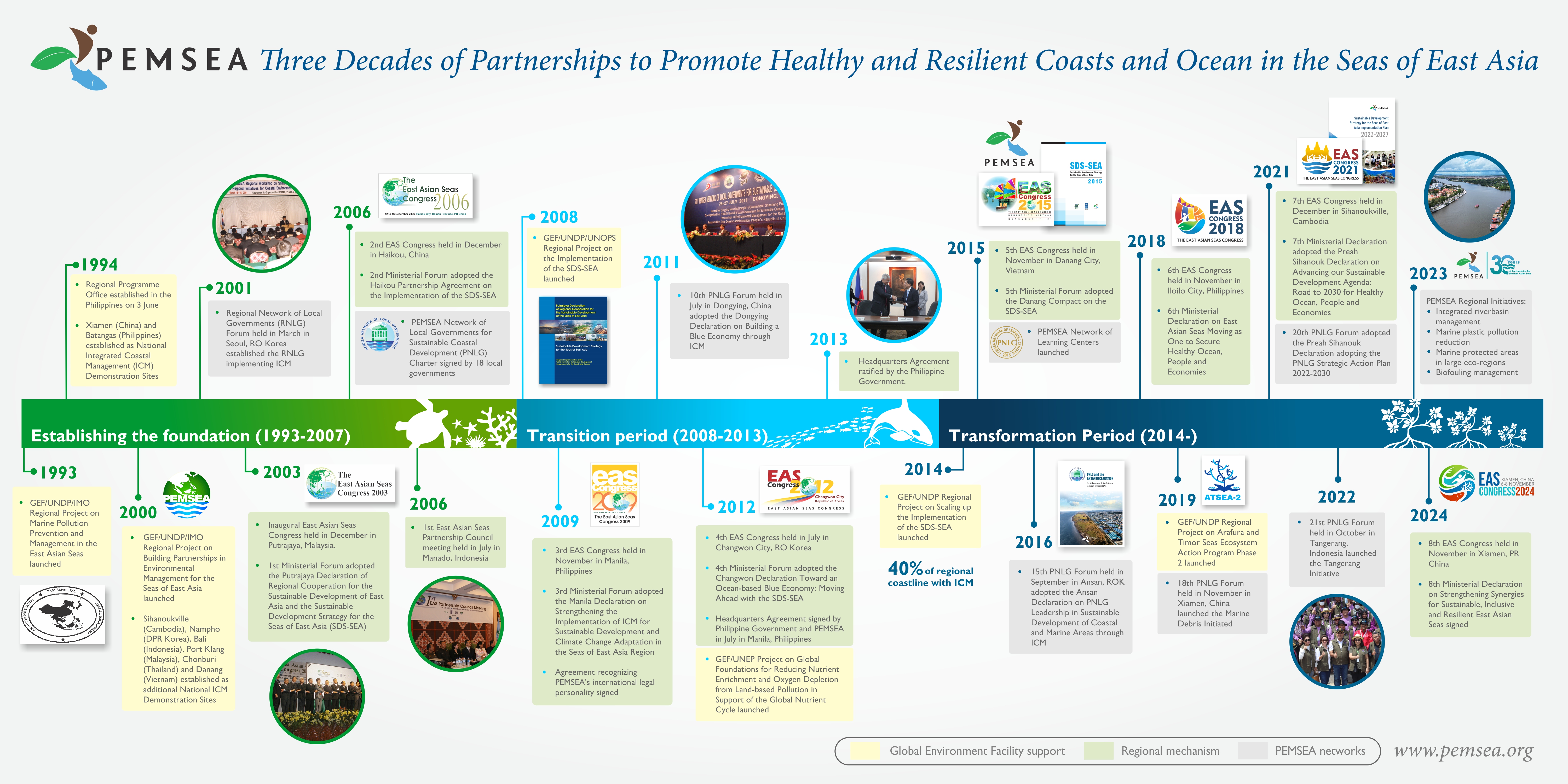
Breadcrumb
OUR STORY
Partnerships in Environmental Management for the Seas of East Asia (PEMSEA) is a regional coordinating mechanism for the sustainable development of coastal and marine areas in the East Asian Seas region. PEMSEA has 11 Country Partners (CP) and 21 Non-Country Partners (NCP) to implement the Sustainable Development Strategy for the Seas of East Asia.
PEMSEA started in December 1993 as a regional marine pollution project in the region. The project, known then as the Prevention and Management of Marine Pollution in the East Asian Seas, implemented by the United Nations Development Programme (UNDP) and executed by the International Maritime Organization (IMO), while the Government of the Philippines hosted the regional project office within the Department of Environment and Natural Resources (DENR) compound in Quezon City, Philippines. It was funded by the Global Environment Facility (GEF) and part of the first international water project.
A considerable focus was placed on the prevention and management of marine pollution by setting up integrated coastal management (ICM) pilot sites in Xiamen (PR China) and Batangas Bay (Philippines); mobilizing subregional efforts (Indonesia, Malaysia and Singapore) to address marine pollution problems in the Straits of Malacca and Straits of Singapore; and strengthening capacity development, especially in developing countries such as Cambodia, PR China, DPR Korea, Indonesia, Philippines, Thailand, and Viet Nam.
The successful completion of the pilot phase project in September 1999 led to the building of confidence and recognition of the need to develop stakeholder partnerships in addressing the increasing environmental challenges in the seas of East Asia. A second phase project (1999–2007) focusing on building intergovernmental, interagency and multisectoral partnerships in environmental management was supported by GEF, with implementation beginning in October 1999. The thrust of the new project was to build partnerships, hence, the acronym PEMSEA to represent the new project initiatives.
The major focus of the PEMSEA project included:
- Formulation and adoption of integrated approaches to managing land and water uses, from river basins to coastal seas, among participating countries in response to the challenges of climate change, sea level rise, loss of biodiversity, depleting fisheries and marine resources, severe degradation of water quality, and increasing multiple-use conflicts in the coastal and marine areas;
- Development of human resources in areas of planning and sustainable management of coastal and marine areas through innovative capacity development programs such as promoting horizontal learning among stakeholders, south-south and north-south learning, on-the-job learning, as well as formal and informal training programs;
- Demonstration of ICM as a systematic and effective approach to managing land and water uses in coastal areas, and scaling up of ICM initiatives; and
- Development and adoption of a sustainable regional mechanism to augment national and regional commitment to protect and manage the coastal and marine environment of the Seas of East Asia.
In December 2003, participating governments and collaborative partners endorsed the Sustainable Development Strategy for the Seas of East Asia (SDS-SEA), a document that outlines a shared vision as well as the collective strategies and approaches to achieve the goals of sustainable development for the region. The implementation of the SDS-SEA requires a long-term commitment, policy reforms, strategic management interventions and significant financial resources.

In June 2007, the GEF Council approved the Phase I of a 10-year project (2007–2017) to implement the SDS-SEA, which facilitates PEMSEA's transformation into a self-sustaining regional operating mechanism. GEF will provide the necessary financial support to cover the incremental costs of addressing regional environmental issues that are of global significance via implementation of the SDS-SEA.
In 2009, PEMSEA gained international legal personality, and PEMSEA together with the SDS-SEA, was recognized as the regional coordinating mechanism and framework for the sustainable management of the seas of East Asia. PEMSEA began work on the blue economy while scaling-up ICM activities.
In 2014 the SEA Knowledge Bank was established with support from World Bank, serving as a repository for reference materials for ICM from throughout the region.
In 2015, the PEMSEA Network of Learning Centers (PNLC) was established, bringing academia and coastal development closer together. During this year PEMSEA rebranded to reflect its expanded role and its international personality, moving from the older 'circle' logo to the current 'propeller' logo. The new logo reflected the interactions of the coast, the oceans, and people, moving together towards a more sustainable future.
In 2016, PEMSEA launched the Youth Program, before launching the PEMSEA Network of Young Leaders (PNYL) in 2018. Towards the end of 2018, PEMSEA released Local Contributions to Global Sustainable Development Agenda : Case Studies in Integrated Coastal Management in the East Asian Seas Region, containing lessons from its 25 years of integrated coastal management.
In 2023, PEMSEA marks its 30th year of working for a more inclusive and sustainable development of the seas of East Asia through integrated coastal management and focused programmes and projects in helping address the global crises on climate change, biodiversity loss, and pollution.